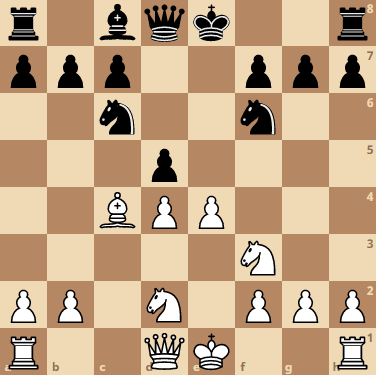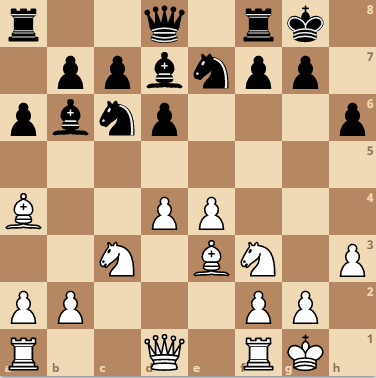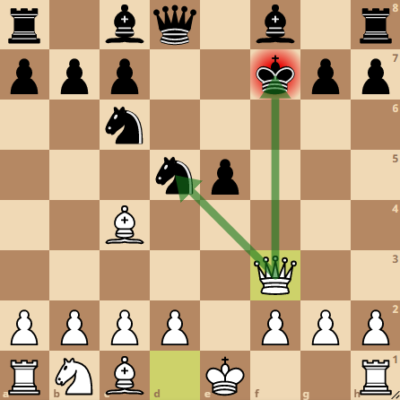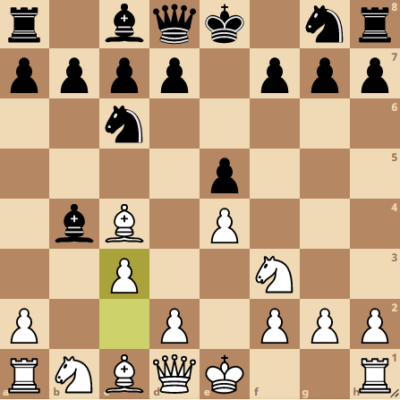The Italian Game Opening is one of the most popular openings played by a lot of Beginner Level Players. Let’s take a deep dive into this interesting opening.
Table of Contents
Definition
This is one of the oldest openings in the history of chess which is characterised by the development of the kingside Bishop to the c4 square. The c4 square is an excellent square for the Bishop as it gets to control Black’s crucial f7 square. Post castling, the White Bishop on c4 will be pinning the Black pawn on f7 and the King on g8.
- e4 e5
- Nf3 Nc6
- Bc4
History
The opening is mentioned in the Göttingen manuscript and is one of the oldest recorded openings. This opening was developed by Domiano and Polerio and later by Greco in the 16th and 17th century respectively. The mainline of this game was developed by Greco. A common term used for the Italian Game Opening is ‘Giuoco Piano’; however, this is a variation of the Italian Game.
Mainline
There are two variations of the mainline of the Italian Game Opening depending on Black’s responses:
- …3.Bc5 (Giuoco Piano)
- …3.Nf6 (Two Knights Defense)
Giuoco Piano

This word means “quiet game” in Italian and is called so as it is relatively calm compared to the sharper possible lines. Bc5 is the most solid response White can give to the move Bc4. The game then progresses into White playing d3, the Giuoco Pianissimo, also called the very quiet game, or White can play c3 on the 4th move, which is the mainline. After d3, Black usually plays Nf6 followed by castling, and both sides develop their pieces. Ng5 doesn’t work for White in this position since Black has castled and the f7 pawn is well protected.
4.c3
This is White’s most popular move in response to Bc5. Playing d4 post c3 is a great option for White as White gains control over the centre and attacks the Black Bishop on c5. In some cases, White may even delay c3 by castling first.
- e4 e5
- Nf3 Nc6
- Bc4 Bc5
- C3 Nf6
- d4 exd4
- cxd5 Bb4+
- Bd2 Bxd2
- Nbxd2 d5!

Black’s Responses to Giuoco Piano
- 4..Nf6 – this variation is mentioned in the c3 variation above
- 4..Qe7
- 4..d6
2..Qe7
Black’s intention behind Qe7 is to keep the center closed and to avoid exchanges. White responds with castling and continues development. Even though Black’s idea is to keep the position closed with this move, White has multiple pawn breaks to open up this position. White can now develop of the queen-side.
3..d6
- e4 e5
- Nf3 Nc6
- Bc4 Bc5
- c3 d6
- d4 exd4
- cxd4 Bb6
- Bb5 Bd7
- Nc3 Nge7
- O-O O-O
- h3 a6
- Ba4 h6
- Be3

Two Knights Defense
When White responds to Bc4 with Nf6, this line is called the Two Knights Defense and is more aggressive when compared to the Giuoco Piano variation. This variation is widely popular and is associated with the Russian Master of the 19th century – Mikhail Chigorin. A common response to Nf6 is Ng5, threatening Nxf7. Black will now have to give up the d pawn in order to prevent the Knight fork. Giving a pawn is the best option to continue development, as development is more critical in the initial stages of the game.
- e4 e5
- Nf3 Nc6
- Bc4 Nf6
- Ng5 d5
- exd5
The Fried Liver Attack
If Black responds to exd5 with Nxd5, then White can play Nxf7, sacrificing the Knight for the f7 pawn. This is called the Fried Liver Attack. Black now plays Kxf7, and white plays an excellent move – Qf3, forking the Black King on f7 and the Black Knight on d5. White regains the sacrificed Knight and also wins a pawn, while Black cannot castle now.
- e4 e5
- Nf3 Nc6
- Bc4 Nf6
- Ng5 d5
- exd5 Nxd5
- Nxf7 Kxf7
- Qf3+

5.. Na5
Na5 is the most popular response to exd5, where Black gives up a pawn to maintain an active position.
Black may also play Nd4 anticipating c3, which is called the Fritz Variation.
Traxler Counter Attack
The Traxler Counter Attack is a variation of the Two Knights Defense and is the most dangerous attack in the Italian Game, where the White Knight moves to g5 to attack the f7 pawn. Black ignores this threat in this variation and plays Bc5 instead of a conventional d5. The main idea is that if White plays Nxf7, Black counters this by playing Bxf2, attacking the White King. White is seen to have a hard time moving its Queenside pieces in this variation.
- e4 e5
- Nf3 Nc6
- Bc4 Nf6
- Ng5 Bc5
- Nxf7 Bxf2+
- Kf1 Qe7
- Nxh8 d5
- exd5 Nd4
- Kxf2 Bg4
- Kf1 Ne4+
- Ke3 Bf5
- g4 Qg5+
- Kd3 Qxg4
- b3 b5
- Rg1 bxc4+
- Kxc4 Nd6+
- Kc3 Ne2+
- Kb2 Nc4+
- bxc4 Qd4+
- Qa3 Qc5+
- Kb3 Rb8+
- Ka4 Qxc2#

Variations
Blackburne Shilling Gambit
This gambit is also referred to as Kostic Gambit where Black responds to White’s Bc4 with Nd4. The idea behind Nd4 is to set a trap – if White plays Nxe5 on the fourth move, then Black can play Qg5 and gain material.
Chigorin Trap
- e4 e5
- Nf3 Nc6
- Bc4 Bc5
- d3 Nf6
- 0-0 d6
- Bg5 h6
- Bh4 g5
- Bg3 h5
- Nxg5 h4
- Nxf7 hxg3
- Nxd8 Bg4
- Qd2 Nd4
- h3 Ne2+
- Kh1 Rxh3+
- gxh3 Bf3#

Evan’s Gambit
This gambit was invented by William Evans and a Welsch sea captain in 1820 and is characterised by the move b4. The idea is to sacrifice a pawn so that White can play d4. If black plays Bxb4, White can play c3 to gain tempo followed by d4. Black may even respond with Ba5, keeping the White Bishop on the same diagonal to prevent White from developing the c and d pawns immediately.

Italian Game Slow Variation
This variation is deceptively strong which is adapted after the Giuoco Piano Variation where White can either play c3 or d3 to occupy control over the center. The eventual plan for White is to castle king-side and then play h3 to prevent Black’s Knight or Bishop from coming to the g4 square.
Strategies for White in the Slow Variation
White is trying to get the Knight on g3 or e3 and to eventually play d4. The f5 square is also a strategically strong square for White to place the Knight to threaten Black. This White Knight is also sacrificed sometimes on the g7 or h6 squares.
Hungarian Defense

The Hungarian Defense is Black’s response to the Italian Game Opening with the move Be7. This is not a very popular opening but is played by a few Grand Masters from time to time. The idea is that Black avoids the complex positions that come up in Guioco Piano and the Two Knights Defense variations. White’s best response to this move is to play d4 to gain control in the center.
Traps in the Italian Game
Max Lange Attack
In this variation, White plays d4 immediately after White plays Nf6. If Black captures the d4 pawn with ‘e’ pawn, the Max Lange Attack begins.
- e4 e5
- Nf3 Nc6
- Bc4 Bc5
- 0-0 Nf6
- d4 exd4
- e5 d5
- exf6 dxc4
- Re1+ Be6
- Ng5 Qd5
- Nc3 Qf5
- Nce4 0-0-0
- g4 Qe5
- Nxe6 fxe6
- fxg7 Rhg8
- Bh6 d3
- c3

Smothered Mate:
- e4 e5
- Nf3 Nc6
- Bc4 Nd4
- Nxe5 Qg5
- Nxf7 Qxg2
- Rxf1 Qxe4+
- Be2 Nf3#

Importance of the f5 Square
The f5 square is a crucial square to pose a continuous threat to Black’s kingside in this opening. As the game progresses, if White manages to eradicate the g7 pawn, the f5 square is a great square to place the Knight to pose a threat on the Black King.
Statistics – Giuoco Piano
| RESULT | PERCENTAGE |
|---|---|
| White Wins | 37.4% |
| Draw | 32.9% |
| Black Wins | 29.6% |
Step by Step Study
Famous Games Played
Books to Refer to:
Faq
Why play the Italian Game Opening?
This opening is easy to learn and does not require too much memorisation or teaching, making it the best opening for beginners. Further, this opening is straightforward and easy to follow, making it an attractive opening for every player to play.
Is the Italian Game Opening good for beginners?
Since this opening does not require too much memorization, teaching or skill, it is a great choice for beginners.
Why is the f7 square important?
The f7 square can be attacked or the pawn on the f7 square can be captured in some variations of the Italian Game Opening, causing an exposure of the Black King and an opportunity for White to attack the King-side. Hence it is extremely important for Black to castle as soon as possible. The White Bishop on c4 is directly attacking the f7 pawn in the opening.
Learn Chess. Learn Life Lessons.
Leran Chess from the GrandMasters.
Help your child improve their Strategic Thinking, Critical Thinking, Time Management, etc. through the game of Chess.

This article is technically edited and reviewed by Grand Master Marian Petrov.

CHESS KLUB offers chess classes for kids and adults of all levels. Our coaches include FIDE, National, International and Grand Masters among many.
We offer Online and Classroom coaching.
CHESS KLUB has coaching centers in the US and India now!
More on Italian Game Opening
More Chess Openings
Learn Chess from the Masters
Do you want to see your kid excel in Chess?



